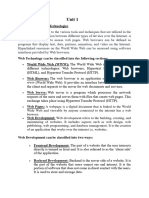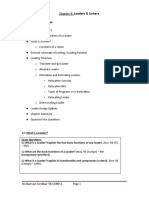Web Design & Development
Uploaded by
Muzammal HussainWeb Design & Development
Uploaded by
Muzammal HussainWeb design and Web Development
Web design and web development are two interrelated disciplines that collectively contribute
to building and maintaining websites and web applications. Let's delve into each of these
areas in detail:
Web Design:
Web design focuses on creating the visual aesthetics and user experience of a website. A web
designer's role is to combine creativity, design principles, and user-centric approaches to
make websites visually appealing, intuitive, and easy to navigate. Here are some key aspects
of web design:
Visual Design: Web designers use graphic design tools like Adobe Photoshop, Sketch, or
Figma to create the visual elements of a website, including layouts, color schemes,
typography, icons, and images.
User Experience (UX) Design: UX design involves understanding users' needs and behaviors
to optimize the website's usability. This includes creating intuitive navigation, clear
call-to-action buttons, and a seamless user journey.
Responsive Design: Designing websites to be responsive ensures they adapt and display
correctly on various devices and screen sizes, from desktops to smartphones and tablets.
Prototyping: Web designers often create interactive prototypes using tools like Adobe XD or
InVision to showcase the website's flow and functionality before development begins.
Web Accessibility: Designers should consider accessibility guidelines to ensure the website
is usable by people with disabilities, such as providing alternative text for images or using
proper semantic HTML elements.
Web Development:
Web development involves turning the design into a fully functional website or web
application. Web developers use various programming languages and frameworks to
implement the frontend and backend components of a website. There are three primary
categories of web development:
Frontend Development: Frontend developers work on the client-side of a website, which is
what users interact with directly in their web browsers. Key technologies include:
HTML: Defines the structure and content of web pages.
CSS: Styles and formats the HTML elements to control the website's appearance.
JavaScript: Enables interactivity and dynamic features on the website.
Additionally, frontend developers may use libraries and frameworks like React, Angular, or
Vue.js to build more complex and interactive user interfaces.
Backend Development: Backend developers handle the server-side of a website. They deal
with data storage, processing, and server communication. Key technologies include:
Server-side programming languages (e.g., Python, Ruby, PHP, Java, Node.js)
Databases (e.g., MySQL, PostgreSQL, MongoDB)
Web servers (e.g., Apache, Nginx)
Full-Stack Development: Full-stack developers are proficient in both frontend and backend
development. They can work on all aspects of web development, from designing the user
interface to implementing server logic and managing databases.
The development process often involves version control using platforms like Git and
collaboration using project management tools.
Web design and web development often go hand-in-hand, and many professionals are skilled
in both areas, known as "web designers/developers" or "front-end developers with design
skills." Understanding the principles of both disciplines is beneficial in creating cohesive and
functional websites.
You might also like
- On Translating Arabic (Cultural Approach) - Opt100% (1)On Translating Arabic (Cultural Approach) - Opt238 pages
- Discussion Web Development and ProgrammingNo ratings yetDiscussion Web Development and Programming11 pages
- A Beginners Guide to Frontend Development Building the WebNo ratings yetA Beginners Guide to Frontend Development Building the Web1 page
- CODE ANAMBRA Pre-Screening Test Study ResourcesNo ratings yetCODE ANAMBRA Pre-Screening Test Study Resources10 pages
- Unit 1 Introduction To Web TechnologiesNo ratings yetUnit 1 Introduction To Web Technologies12 pages
- Difference Between Front-End and Back-End DevelopmentNo ratings yetDifference Between Front-End and Back-End Development4 pages
- What Is The Difference Between A Web Designer and A Web Developer?No ratings yetWhat Is The Difference Between A Web Designer and A Web Developer?3 pages
- Fundamentals of Web Design and Programming (Introduction)No ratings yetFundamentals of Web Design and Programming (Introduction)47 pages
- Web Development: Submitted By: Saurabh Srivastava Roll No: Submitted ToNo ratings yetWeb Development: Submitted By: Saurabh Srivastava Roll No: Submitted To15 pages
- Best Way To Understand Programming and WebNo ratings yetBest Way To Understand Programming and Web4 pages
- What Is Web Design?: Tools and TechnologiesNo ratings yetWhat Is Web Design?: Tools and Technologies3 pages
- Web Development and Divide Into 4 PartsNo ratings yetWeb Development and Divide Into 4 Parts22 pages
- Web Designing Training Course in Chandigarh@00001No ratings yetWeb Designing Training Course in Chandigarh@000015 pages
- Fundamentals of Web Design and Programming (Introduction)No ratings yetFundamentals of Web Design and Programming (Introduction)51 pages
- 3D Game Engine Design A Practical Approach to Real Time Computer Graphics 2nd Edition David H. Eberly - Get instant access to the full ebook with detailed content100% (2)3D Game Engine Design A Practical Approach to Real Time Computer Graphics 2nd Edition David H. Eberly - Get instant access to the full ebook with detailed content57 pages
- Libraries Comm Controller DOC V1 1 1 enNo ratings yetLibraries Comm Controller DOC V1 1 1 en113 pages
- PDF Transformer, BERT, and GPT: Including ChatGPT and Prompt Engineering (MLI Generative AI Series) 1st Edition Campesato download100% (5)PDF Transformer, BERT, and GPT: Including ChatGPT and Prompt Engineering (MLI Generative AI Series) 1st Edition Campesato download40 pages
- Public Cloud Security 6.0 Study Guide-OnlineNo ratings yetPublic Cloud Security 6.0 Study Guide-Online178 pages
- Mobile Operating System: Raghav Arora, Rana Rahul Sathyaprakash, Saurabh Rauthan, Shrey JakhetiaNo ratings yetMobile Operating System: Raghav Arora, Rana Rahul Sathyaprakash, Saurabh Rauthan, Shrey Jakhetia7 pages
- Bosch Video Management System - Configuration Manual100% (1)Bosch Video Management System - Configuration Manual260 pages
- HTML Cheat Sheet - A Simple Guide To HTMLNo ratings yetHTML Cheat Sheet - A Simple Guide To HTML6 pages
- Castle in The Sky: Dynamic Sky Replacement and Harmonization in Videos100% (1)Castle in The Sky: Dynamic Sky Replacement and Harmonization in Videos11 pages
- Formatting Document Processing Lessons 61 120 2nd Edition Susie H. Vanhuss 2024 Scribd Download100% (4)Formatting Document Processing Lessons 61 120 2nd Edition Susie H. Vanhuss 2024 Scribd Download50 pages

























































































